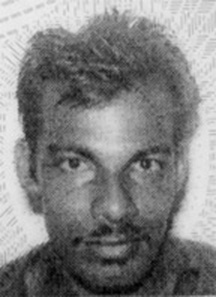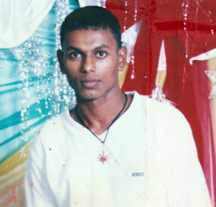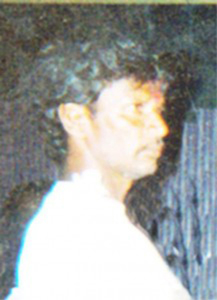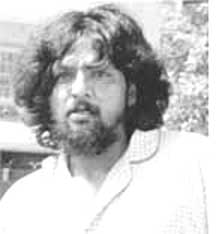The incidents of detainees found hanging in police station lock-ups remain an area of concern and the most recent case has renewed calls for this issue to be taken seriously and for the layout of holding facilities to be urgently reviewed.
There have been seven such incidents from 2008 to 2013, based on Stabroek News’ records, and while autopsies confirmed that in all cases the deaths were as a result of hangings, the families of the dead have often rejected the police’s accounts that suggest suicide.

Omesh ‘Radesh’ Thakurdin of Number 72 Village, Corentyne is the most recent case and the first recorded for 2013. He was the suspect in the murder of US army doctor Captain Max Kungel. Kungel and Thakurdin were cousins.
Thakurdin, an employee in the field lab at the Skeldon Estate, was detained last Monday at the Springlands Police Station for questioning. According to the police, that night he was taken to the Number 51 Police Station around 8.50 pm and around 5.20 am the following day, officers found him hanging by his shirt from the grill of a holding cell. He was the only person in the cell, according to police.
However, the man’s relatives remain adamant that Thakurdin was not suicidal and that he probably took his life out of fear. They also expressed disappointment that they were not called to see the body hanging. Police only made contact with the relatives after the body had been removed from the cell and transported to the morgue.
On February 17, 2012, police said that Ryan Singh, 27, of Campbell Street, Williamsburg, Corentyne was found hanging in the lock-ups at the Rose Hall Police Outpost. Singh had been arrested the same day following a report of larceny of a bicycle, which he was allegedly found to be in possession of. He was placed in the lock-ups and during a subsequent visit to the lock-ups police said he was found hanging from the inner grilled ceiling by his jersey. The police said had that the prisoner had stripped his jersey into pieces and joined the pieces together, and tied it around his neck. Like Thakurdin, he was the only prisoner in the lock-ups.

Chris Primus, 20, was found hanging in the Bartica Police Station lock-ups that he was sharing with two other prisoners on September 11, 2011. The murder accused was found hanging around 7.30 am and according to the police his cellmates said that they were sleeping at the time and did not hear anything unusual. The prisoners were last checked around 4 am.
According to the police, Primus appeared at court in Bartica two days earlier in connection with a charge that he murdered Sylvester Simon at Apaikwa Landing, Enachu, during August 2010 and the matter was discharged. He was, however, rearrested and placed in custody pending further legal advice.
In March 2009, Deodat Persaud, 45, who had been reported missing by his relatives, was found hanging in the Number 51 Police Station lock-ups during a routine check. Relatives, after being told that he had jumped off a fishing vessel in Suriname, had made a missing persons report to the police. Persaud was later found alive in Suriname by relatives and taken to Springlands Police Station.
Police checked their records and found that he was a suspect in a break and enter and larceny matter committed on a fisherman and as a result he was detained and subsequently transferred to Number 51 Police Station. He was found hanging in the lock-ups the following afternoon.
The Police Force’s Office of Professional Responsibi-lity (OPR) had launched an investigation into the man’s death but it is unclear what came of it. The man’s family had questioned his death and said that they were looking for answers.
On February 10 of the same year, Mahendra Seenarine was found hanging in La Grange lock-ups after being arrested and a post-mortem examination had revealed that he died from asphyxiation due to hanging. Seenarine, 38, and a labourer of Good Land, Canal Number One, West Bank Demerara, was discovered hanging by his belt from a ventilation window on the door of the lock-ups during a routine check, the police had said at the time.

Surindranauth Bhoojnaut, a 31-year-old Belmont, Mahaica resident was found hanging in the lock-ups at the Mahaica Police Station on June 3, 2008. He had been placed there after he allegedly hit a woman with whom he had a pending court matter. He had reportedly created a noose with his belt, which he attached to the bars of a ventilation window on the southern wall of his cell.
In January of that same year, Ramesh Sawh, 19, was found hanging by his jersey in the Enmore Police Station lock-ups. Relatives have refused to accept that he committed suicide, saying that he showed no signs that he wanted to take his own life. Added to that, they said he was in custody for a simple offence which could not have prompted such a drastic action. The matter was taken to the Police Complaints Authority and the Chairman Cecil Kennard recommended that an inquest be held into the death. Six months later Chief Justice Ian Chang ordered that an inquest be held and it was found that the police were criminally concerned. However, there was insufficient evidence to lay a charge against the police in the matter.
Stabroek News was told that harsh disciplinary action was never taken against any of the ranks who were in control of the detainees at the time of their deaths. The ranks were instead transferred to other police stations.
Still looking for justice

Five years after Sawh’s death, his relatives said that they will not give up and will continue to seek justice. An emotional Indrouttie Sawh told Stabroek News that she still hurts as a result of her loss and she said her feelings were “brought alive” again by the latest case in Berbice.
The woman said that what has hurt her even more is that her family did everything in their power to seek justice and in the end they still lost.
“Nothing never came out of this story. They said that the DPP said that there was no substantial evidence to charge the police,” the woman said. She added that while to the justice system and the police, the case is closed, it is not for her. “I am not satisfied with it at all,” she said her voice laced with grief. However, she added that she will leave the matter in the hands of God as she is confident that one day he will give her some answers.
The woman said that the story about hanging from the grill does not add up to her, while noting that her son was not the suicidal type. She questioned why this has not been corrected if that is really how prisoners are getting to hang themselves.
She said that a lot of times, prisoners are under stress and everything must be done to protect them from themselves. “I know that Kenny did not commit suicide,” she, however, said, while adding that she believes that something went horribly wrong during the interrogation progress and he died. She said that it is her belief that the police used suicide as a cover for their actions.
Sawh recalled that following her son’s death, someone who had been turned away from making a report at the station told her that while he was there he saw the police coming out with the body. The woman claimed that the man told her that there was a black plastic bag covering her son’s face. According to her, her son had previously told her that when being questioned by the police, a bag was placed over his face. He had been detained by police in relation to other investigations.
She said she was dissatisfied that the rank involved was transferred to a police station on the East Bank. “They gone and put he in a new, clean police station. That is not right. If the jury said they find the police guilty then it is wrong to just move him. They should have put him off the job and find out the truth of the story”, she said. “I will never take that he commit suicide,” she added.
Redesign

Back in 2009, following the deaths of Persaud, Seenarine, Bhoojnaut and Sawh, Home Affairs Minister Clement Rohee had voiced his concern over the “regular incidents” of hangings and said the redesigning of lock-ups would be looked at to prevent future occurrences. It is unclear if this is still an area that is being looked at by the ministry as well as the Guyana Police Force.
Recently, a security source told Stabroek News that this should be an issue for concern. He opined that the installation of cameras near to or in the holding areas is not the best option as there will be issues of the cameras not working, the footage being of a substandard quality and ranks not monitoring them.
He said the best option would be to have bars covering the entire front of the cell so that ranks can see straight into the lockups without their views being obstructed by a concrete wall.
The source said that based on his knowledge, the best lock-ups design exists at the Vreed-en-Hoop Police Station, where the bars stretch from the ceiling to the floor.
The source made the observation that in the case of hangings, while in police custody nothing comes out of the matters. He pointed out that the circumstances surrounding some of the deaths “don’t make sense.”
He noted that most of the lock-ups tend to “be in some corner” hidden from view and are usually an enclosed space with a small hole with bars at the front. “Why are you hiding the people? They are not guilty of anything. Wherever you put them, the police must be able to see what’s happening,” the source said while stressing that this issue needed to be addressed urgently.




